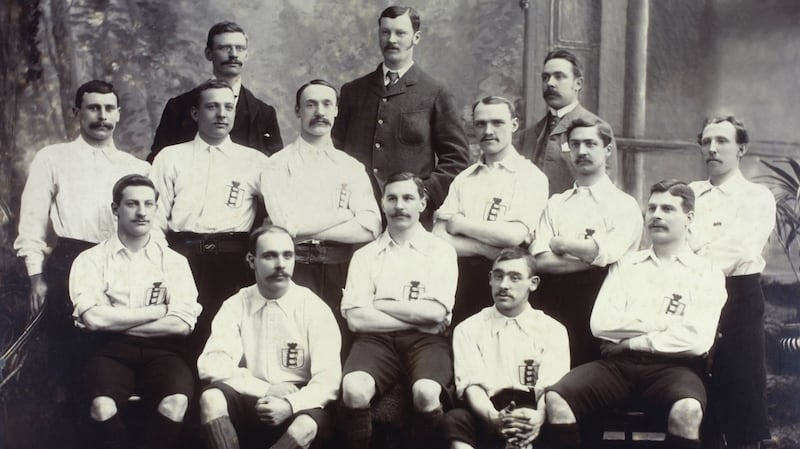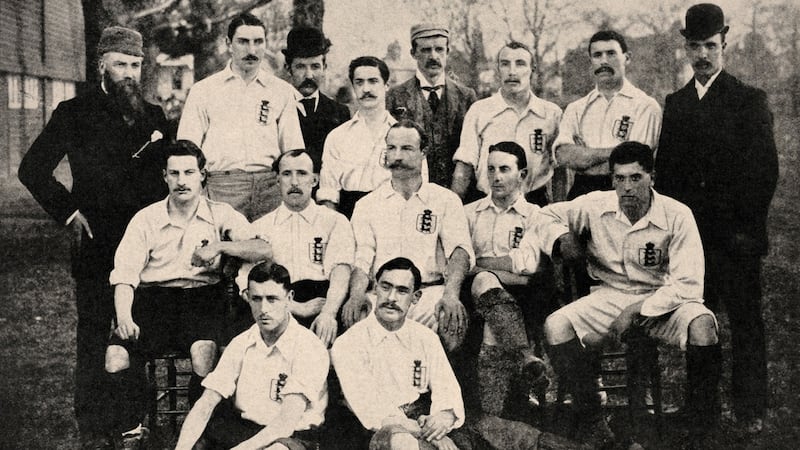There was not a soul around. In a graveyard, that might count as humour and, if so, it was the only dry item in Sheffield’s Burngreave cemetery on Wednesday. At noon a charcoal sky burst open to unleash a torrent.
There was no shelter to be had, not under a tree, nor down at the old sandstone chapel, now padlocked and shuttered. There is no cemetery office. As little rivers of rain began washing down the slope, the graveyard – opened in 1861 – looked its age.
Up the hill at section W1, shrubs and trees sprouted through graves, ivy gripped some, while others had broken or been half submerged. There was that profound cemetery silence. Not a soul around.
Maybe it was appropriate. Maybe it is fitting that a search for a vanished figure once described by the Sporting Life as "perhaps the best known man in England today" should lead to a plot in Sheffield where no headstone, no marker, shows his final resting place. John Reynolds, after all, was something of an international man of mystery.
Reynolds might smile. He was, apparently, a character, of whom Birmingham’s Sports Argus said: “He made the crowd laugh as no other player ever did and there is virtue in that.”
That was on his death. During Reynolds' glory-filled career, there was equally vivid and affectionate testimony. The more you read, the more he sounds like a late Victorian Paul Gascoigne, although in the coming fortnight the footballer Reynolds will be compared to is Declan Rice – or vice versa.
This is because in the 147-year history of England’s and Ireland’s senior internationals, only one man has played for both countries: John ‘Jack’ Reynolds. Rice will become the second.
In 1890 Reynolds made his debut for Ireland against Wales in Shrewsbury. In 1892 Reynolds made his debut for England against Scotland in Glasgow.
In 1890 he was playing for Distillery in Belfast. In 1892 he was playing for West Bromwich Albion on the way to joining the dominant Aston Villa team that won three English titles in four seasons from 1893 and which, in 1896-7, did the league and FA Cup double. It was Reynolds’ third FA Cup win.
He was a star of the land, 28, and in demand. Soon there was a move north to Celtic.
Safe tackler
It was in April 1897, before Villa’s cup final victory over Everton, that the Sporting Life pen portrait opened with the line about Reynolds’ fame. It was a reference to the profile of professional footballers, but also to Reynolds’ abilities:
“He has had a most distinguished career. He has played both for and against England, and also done duty for Ireland, while on one occasion it is hinted Scotland wanted to claim him . . . he is, however, an Englishman having been born at Blackburn, but his parents early removed to Ireland and this is how he came to play for the Emerald as he was supposed to have been born in Belfast.
“Today he is one of the cleverest half-backs in England and is fully entitled to rank as the evergreen. He learned his football in Belfast and in coming to England threw in his lot with West Bromwich Albion. He had a disagreement with the Throstles and threw in his lot with the Villa and has never had cause to regret the change . . . he is a safe tackler and a man who beats him must account himself really clever. His pet pastime is taking penalty kicks.”

And yet, 20 years later, this national figure was on his way to an unmarked grave in Sheffield. How did this happen? Who was John ‘Jack’ Reynolds?
**
He was born, as stated, in Blackburn in February 1869 – though a reporter who knew Reynolds well, suggested he might be older.
Reynolds’ father, George, was in the British Army. He was posted to Ireland and was stationed near Ballymena and in Birr. His son was said to have a Belfast accent.
Young John, or Jack, stayed in Ireland until he was 15. He returned to Blackburn and joined Park Road. In the days when Irish clubs were invited into the English FA Cup, in 1886 Cliftonville drew Blackburn Park Road in the first round. The game was drawn 2-2, The Sportsman reporting “Reynolds equalised”. That meant a replay in Belfast and in front of 3,000, “Reynolds kicked off”. (Cliftonville won 7-2.)
He was 17. A month later he joined the East Lancashire Regiment and played for the regiment’s team. Distillery fancied him, signed him and when, like Cliftonville a season earlier, Distillery drew Blackburn Park Road away in the FA Cup, Reynolds travelled back to Lancashire to play. The English FA, however, declared Distillery’s registration illegal and suspended Reynolds for a year.
He went back to his regiment. A report from November 1889 has him appearing in a friendly at Cliftonville. His suspension was expiring and days later Distillery bought him out of the army. Quickly he was playing against Glentoran and just over two months after leaving the army, Reynolds, 20, made his Ireland debut.
Grand game
It was against Wales (in England). Ireland, in St Patrick blue, lost 5-2 in Shrewsbury but the Birmingham Mail described Reynolds “playing a grand game”, while the local Shropshire paper, Eddowes’s Journal, focused on the previous evening at the Crown Hotel.
“A very successful invitation smoking concert was held,” it said. “A very lengthy and interesting programme” featured solos from various visitors including a song by “Mr Reynolds of the Irish team (encored)”.
Two months later, Reynolds, now 21, had a second cap. It was against England on the Ormeau Road in Belfast. “Play was started at half-past three Irish time,” reported The Sportsman.
The weather was so bad half-time was scrapped. The Irish team, with ten Belfast men in it, lost 9-1. The Irish goal was scored by Reynolds – “a rapid shot”.
He was gaining attention at a time when professionalism was challenging early football’s amateur ethos. Reynolds had left Distillery for Ulster FC, but not for long, the Belfast Telegraph writing: “They [Ulster] have lost the one man who was the mainstay of their team last season, viz Reynolds . . . he has accepted the filthy lucre and now wears the West Bromwich Albion colours”.
It was 1891 and Reynolds had made his fifth and final appearance for Ireland. At West Brom his Lancashire birth became known and England moved. At the end of his first season there, West Brom defeated Villa 3-0 in the FA Cup final with Reynolds scoring the third.

Two weeks later he was at Ibrox making his England debut. His was a rapid shot.
Before the game, the Glasgow Evening Post conducted interviews with England’s players and reported that Reynolds “spoke with a distinct Irish brogue”.
It quoted him on the subject of nationality: “Twitted [teased] on his playing for England he says: ‘I’m sorry I was not born in Old Ireland, but I must play when they [England] ask me.”
The paper referred to “the joke of Reynolds’ selection”, though it added: “England evidently thinks a lot about this player.”
After a 4-1 England victory, The Scottish Referee, said of Reynolds: “There was no cleverer half or better worker on the field. “Reynolds is a wonder for his inches.”
The Belfast Telegraph joined in: "Our old friend, Jack Reynolds, the English-Irishman as he is called, played splendidly."
Spectator sport
In all the comments through the 1890s “clever” is the most common word used to describe him. Reynolds was 5ft 4in, and 12st in one report; he was losing his hair so was known as ‘Baldy’. But he was a main attraction in this growing spectator sport. He had taken 20 penalties by 1895 and not missed one.
By then he was at Villa cementing his reputation as one of the finest half-backs – modern midfielder – in the country. There were eight England caps to go with the five for Ireland.
Issues still arose. Clubs were not generous, then there was a reputation for drink and women.
He left Villa for Celtic in 1897, but soon left for a short period with Southampton. Then in 1899 there was a court appearance for failing to keep up payments to an illegitimate child he fathered by his landlord’s daughter.
Coaching in New Zealand may have sounded a good idea then, so Reynolds opted for that. On return he is mentioned at Stockport County and Cardiff City.

And then, it seems, no-one spoke of John ‘Baldy Jack’ Reynolds. He faded into the background of everyday life, settled in Sheffield and worked at a coal mine.
In the middle of March 1917, the Birmingham Mail reported: “The death occurred at Sheffield rather suddenly, on Tuesday, of a miner named John Reynolds, and circumstances which have subsequently come to light point to the identity of the deceased with the famous international footballer.”
The paper ran through Reynolds’ career and concluded: “He gained every honour possible in the game.”
In Belfast the News Letter carried one paragraph beneath a headline: “Death of an Irish International”. In Sheffield the sports paper the Green ‘Un said: “He was young, only 47, but he had dropped out of sight for many years and few people knew that he was working in this neighbourhood.”
I really believe that he was the most stunning player I ever watched
There was shock, but then as ‘Nomad’ in the Sports Argus noted, Europe had got used to shock and death. The Allies were capturing Bapaume that week.
‘Nomad’ produced a sweet tribute, nonetheless, to a man he said was “always doing the unexpected.
“John Reynolds was a genius; a great genius. I think he had as much genius for the game of football as any man that ever played . . . he was a magician with his head, and his back-heeling has never been excelled. He had dozens of tricks, too, little tricks that are indescribable . . . I really believe that he was the most stunning player I ever watched.
“John had a good rugged Irish face; to all intents and purposes he was an Irishman although it was quite true that he was born at Blackburn . . . I could tell you a page of yarns; some of the best would have to be left out. He was a splendid companion . . . Providence did not fashion him in the form of a hoarder of wealth.”
***
Back at Burngreave cemetery, the rain had ceased. At section W1, another check of the mossy ground for plot 69 brought Yorkshire surnames such as Armitage, Hinchcliff and Howarth but still no Reynolds.
Without a headstone there is a doubt if this really is the resting place of John Reynolds, though Sheffield Council's archive says that a burial of a John Reynolds, formerly of 52 Greystock Street in the city, had taken place "in Consecrated ground; Grave Number 69, Section W1 of Burngreave Cemetery, Sheffield. Officiating Minister LE Day. "
Plus, the volunteers who tend the graves, Friends of Burngreave Cemetery, replied to say that there was never a headstone on this plot – there must not have been the money – but there is a grave.
Five people lie here, the names and dates show, from 1884 on. One is John Reynolds and if this is the only man to have played for Ireland and England, he died at Sheffield Infirmary in March 1917 and was buried here four days later, on St Patrick’s Day.
* Thanks to Sheffield City Archive and Friends of Burngreave Cemetery.




















